In the ever-changing world of SEO, the dynamic search landscape constantly affects your rankings, traffic, and conversion rates.
So how can digital marketers swiftly respond to changes, prioritize actions, and achieve SEO success?
The answer lies in efficient and meaningful data analysis. But taking a broad overview of a website’s organic search performance data often obscures the answers to the big questions that arise with each change:
- What happened?
- What was impacted?
- How big was the impact?
- What should be the priority to address?
- Why did it happen?
That's where segmentation comes into play. Segmentation is a key SEO strategy that enables you to digest your site’s data and draw important insights more easily by breaking it into meaningful groups.
In this guide, you’ll learn how to use segmentation to analyze at scale and turn your data points into actionable tasks.
Table of Contents:
What Is SEO Segmentation?
As a marketing methodology, segmentation allows you to take a problem, break it into its component parts and then create groups based on common characteristics between them.
That way, you can zoom into those groups and perform analysis at scale.

What you may not realize is that we use segmentation constantly in our daily lives. People segment their finances when they look at their spending by category (dining out vs. groceries) and create budgets by category.
Or they might segment their workouts to determine how many calories they burn during 20 minutes of running vs. swimming, or during different strength training exercises. It’s a powerful concept that allows for purposeful analysis.
Essentially, the SEO segmentation framework has three steps:
Step 1: Identify elements
Step 2: Identify the common characteristics between the elements
Step 3: Create a group and analyze
You gather a list of all the available elements and look through the elements to see what are the common characteristics. Then, you create a group. Take the image below, for example.
.png?width=400&height=422&name=segmentation%20example%20(1).png)
In the image, the colored dots can be segmented in a variety of ways: color, shape, size, size and color, color and shape, etc.
You can segment anything in SEO - pages, keywords, topics, metrics, competitors. And, it is important that you do this to be able to analyze trends, opportunities, and competition, and content!
Why Use SEO Segmentation?
Let’s apply this marketing strategy to SEO. Whether you’re looking for a high-level overview of your site’s performance or you’re tracking the results of an individual search campaign, segmenting SEO allows you to take a pointed look.
Then, you can draw conclusions that inform your next steps on how to boost your site's performance.
Segmentation for Keywords and Pages
If you’ve already created your keyword portfolio, grouping keywords allows you to chunk the data into useful combinations based on targeted pages, metrics, and even competitors.
That way, you can answer those five big questions from above and confront the change head on.
Segmentation for Site-Wide Types and Patterns
Tracking site-wide types provides a macro-level overview of your search data at the highest level. This includes data on all of the pages on your site and all of the different keywords driving traffic to your site.
Because it is pattern-based, your groupings must match a pattern – usually a part of the URL structure.
For instance, content marketers could compare the performance of category pages vs. landing page traffic, or compare all keyword search result pages with product detail pages, as all of these elements typically have an identifying characteristic in the site architecture or in the URL structure.
For this example, traffic increased week over week so everything is great. Everything is performing well so just move forward, right? Now, your next question should be, what is working and how can we accelerate it?
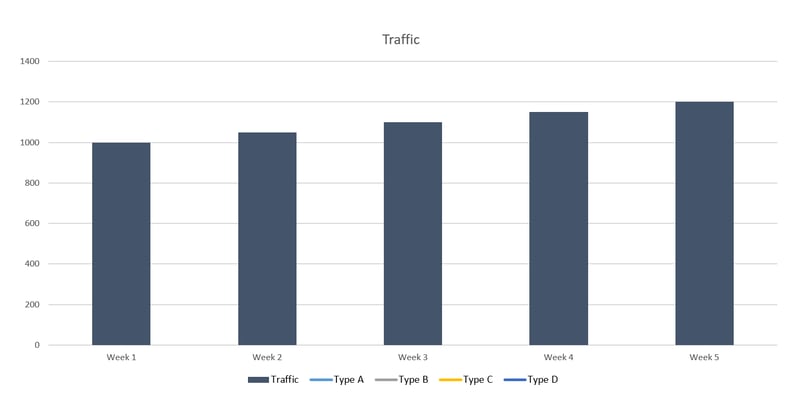
But, if you break up your pages into different content types, it provides a clearer picture of which areas may have lost traffic and which have gained it.
These page segments paired with keyword segments help you take a smarter look at your data. When you peel back the layers, you can identify underlying issues and opportunities.
Segment A, how do I accelerate that group, but we also need to prioritize what issue occurred in segment B and C.
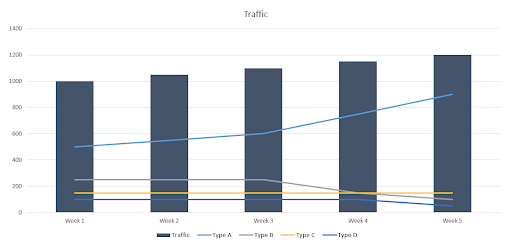
Typically, when looking at your site-wide rankings, averages can be misleading. They might even obscure opportunities.
For example, you may have gained two ranking positions and lost two others, but when taking an average, they would cancel each other out. But if you target the 2 lost keyword rankings, you have the opportunity for a net growth of 4 rankings.
How Does seoClarity Approach SEO Segmentation?
seoClarity’s Clarity Grid™ architecture gives clients powerful capabilities to slice, dice and analyze their data across a variety of data sets.
For every imaginable way you can think of segmentation and SEO, seoClarity can be custom-configured to your unique site and specific use cases. Or, if you prefer, there are also many places in the platform that pre-built segments already exist.
You even have the ability to create segments in bulk across your entire site in seconds using the power of ChatGPT in the platform.
From small- to large-scale analysis, use keyword groupings to track search data across content types or by searcher intent. There are three main ways the seoClarity platform can help.
Pre-Built Segments Already in the Platform
Clarity Grid features pre-built segments that group your data by page ranking, folder, subdomains, competitors, device type, user intent, location, and more.
Then, you can apply other metrics to these segments, including: average rank, estimated traffic, rank position, and rank range. Selecting any of these filters generates graphs for easy visual analysis.
Pre-built segments are available to use throughout the platform in Search Analytics, Site Analytics, Rank Intelligence, and Research Grid.
This accelerates your SEO analysis to slice, dice, and analyze as soon as you can think through it. There are so many ways to analyze and dive into the data that doesn’t have to be set up in advance.
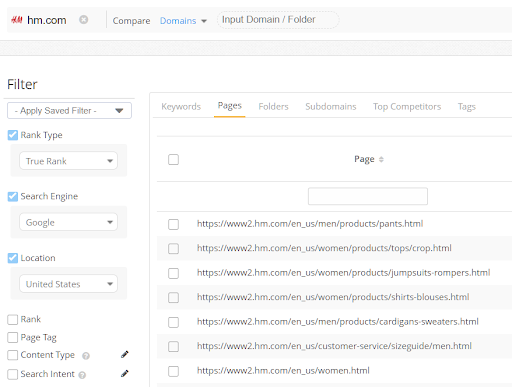
Custom Segments from Tracked Elements (Keywords and Pages)
We also allow for completely arbitrary segments that users create from elements that are already managed in the platform.
seoClarity leverages a “tag” system that allows you to group pages or keywords in a way that makes sense for your business. This includes short and long-tail keywords.
In contrast to the pre-built segments, creating custom filters by grouping keywords or pages provides a micro-level analysis organized by characteristics that are dependent on your business.
Custom segmentation also allows you to sort your site's pages with a hierarchical system using breadcrumbs.
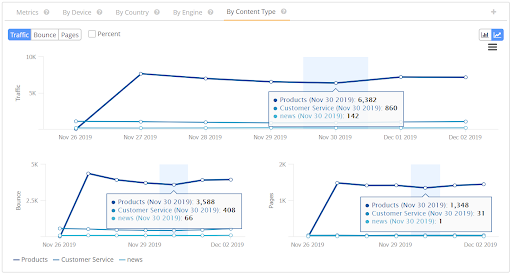
For example, a business might...
- Test the overall performance of 50 pages that they worked to optimize.
- Analyze their e-commerce category pages and then put the five top-performing pages into tags.
- Examine performance across groups, such as: high search volume keywords or low search volume keywords, keyword length, CPC, rank position in the top 3, high importance keywords in the top 3, low performance keywords ranked 90-100, or keywords with second page rankings.
- Use market segmentation to combine one of the above groups with local search data for a specific city or state.
- Compare keyword groups across countries in different market segments.
- Filter out branded keywords to determine the intent behind searchers’ queries.
Site-Wide Segment-Based Patterns
In the platform, you can break down your data into segments based on any kind of identifiable URL (or keyword) pattern (i.e. contains, does not contain, exactly matches, etc) or even leverage a regex pattern. This allows you to segment on-the-fly to do interactive analysis based on that custom segmentation that’s unique to your site.
Within Site Analytics, you can even compare content types to visualize trends between the different content types you have set up. This, of course, is another example of segmentation.
For example, if you are an SEO at a retail store interested to see the traffic for the pages that deal with men’s clothes, you can create a content type that includes the word “men” – this on-the-spot filter allows you to now see the performance of all URLs that include the word “men.”
The compare feature then allows you to see how those pages compare to other URLs. For example, maybe you want to see the performance of all pages whose URL contains “women.”
You’re able to slice, dice, and analyze the data however you see fit to get a closer look at site-rewide information that matters to you.
This capability is available throughout the platform in Rank Intelligence, Search Analytics, Site Analytics, and Bot Clarity.

(Comparison between two content types in Site Analytics.)
How To Set Up Segmentation in seoClarity: Now Possible In Bulk Using ChatGPT
Creating different tags for keywords and pages is super simple. You can upload from a spreadsheet, add on the fly, or even select keywords or pages right within the platform to segment based on your pre-created tags in just two clicks.
In our platform knowledge base for platform users, there’s amazing detail on how to set up segmentation within seoClarity.
Need to create segments in bulk?
Instead of spending hours completing the tedius task of manual tagging across thousands of pages, let AI do the work for you in seconds.
At the click of a button, our AI-driven SEO assistant, Sia, allows you to create entity groupings in mass using the power of ChatGPT. Segmenting possibilities include location, brand name, breadcrumb, product, keyword intent, and virtually any other criteria you can imagine.
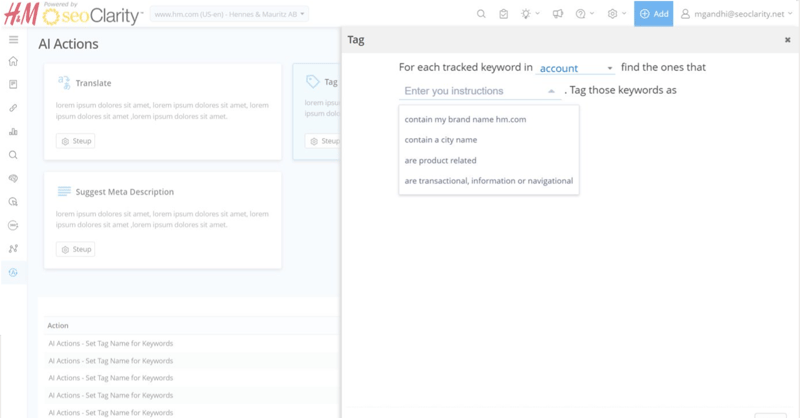
All you need to do is select the preset task, set the parameters, click "Try" to review the results, and then hit "Execute."
How to Set Up Filters for Content Types
Creating content type groups lets digital marketers segment keywords and analyze pages based on common patterns. For example, use them to compare homepages with product pages, or compare different classifications of category pages.
The following steps will help you set up a content type filter:
- Open Research Grid within the platform to create a new filter.
- Give it a name.
- Then include the feature from the URL that denotes that type of content on your website.
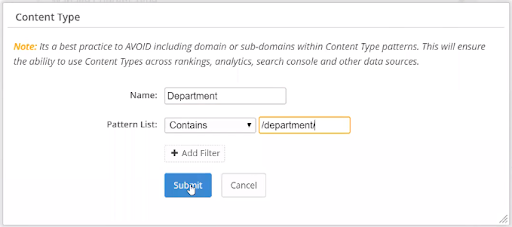
These filters are dynamic and go into effect by pulling from the database immediately, creating a chart that will allow us to see all the metrics broken out by the content types you have created.
It will take all the data to show traffic driving pages by each of these segmented keywords. You could then filter down by one of the content types.
You can use any regular expressions (regex) patterns and implement within seoClarity. More detail on this capability below.
Another helpful point to note: If you create a content type in one tool (like in Search Analytics), it becomes available across the board in other capabilities within the platform immediately.
How to Set Up Filters for Brand vs. Non-Brand Keywords
Setting up this segment shows how much your site is driving non-brand vs. brand performance, which highlights the value of SEO in your digital marketing strategy.
Creating filters for branded and non-branded keywords allow you to group and measure pages with brand inclusion or without.
- Open Search Analytics and create a new filter.
- Add your brand as a branded filter with “contains.” (If you have multiple brands, use a regex to string the different brand names together as a single query: |brand1|brand2|brand3)
- To create a non-branded filter, do the reverse with “does not contain.” (If you have multiple brands, use “Regex Not Match” and the same expression as you used for the branded filter.)
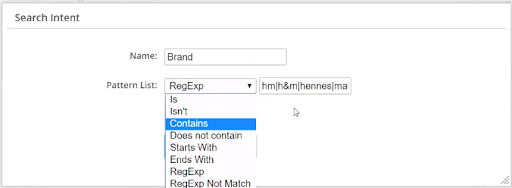
Another bonus, you can also do this by any number of different intents based on your user journey from awareness, transactional, local, etc.
seoClarity also includes a proprietary machine learning algorithm and groups keywords by these different search intents.
If you’ve done this for your keyword portfolio, build those options in the platform so you can leverage that work throughout the platform.
How to Set Up Dynamic Segmentation in the Platform
Dynamic segmentation allows new keywords to be automatically added to an appropriate tag.
This alleviates the need for you to remember where each keyword should be tagged every time you add a keyword or a page, and lets the platform handle all the tedious categorization.
1. Click the + icon on the upper navigation bar

2. Select “Add and Edit Dynamic Rule” under the Keywords and Target URLs section
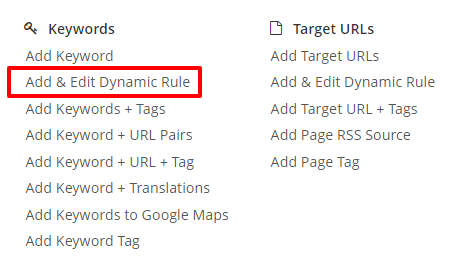 3. Click “Add New Rule.”
3. Click “Add New Rule.”
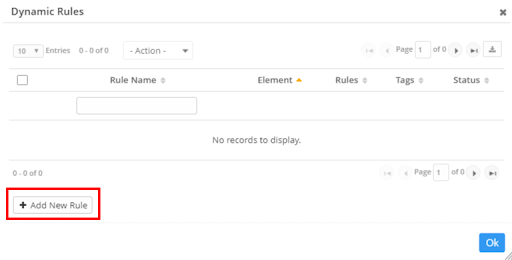 4. Enter the name of your rule. For this example, we call it “Brand Keyword Tagging” to reflect any keywords with direct mention of our brand. Make sure the element is set to “Keyword” since that’s what you’re concerned with here.
4. Enter the name of your rule. For this example, we call it “Brand Keyword Tagging” to reflect any keywords with direct mention of our brand. Make sure the element is set to “Keyword” since that’s what you’re concerned with here.
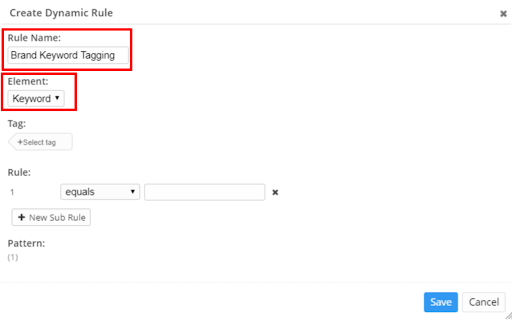 5. Enter your rule and the applicable tag. This tells the system that for every keyword added you want to apply a certain action to it (i.e. categorize it in a certain tag) if it matches the rule. For example, if a keyword contains “seoClarity” it will be added to the Brand Tag.
5. Enter your rule and the applicable tag. This tells the system that for every keyword added you want to apply a certain action to it (i.e. categorize it in a certain tag) if it matches the rule. For example, if a keyword contains “seoClarity” it will be added to the Brand Tag.
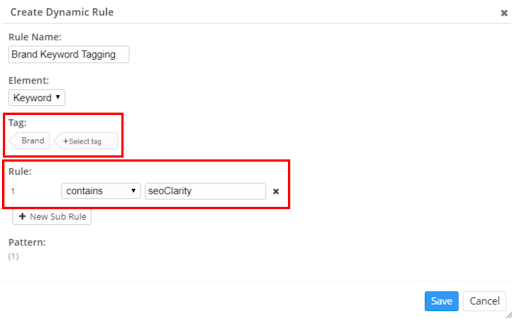 6. This step is optional, but you can add multiple sub rules to further define the rule.
6. This step is optional, but you can add multiple sub rules to further define the rule.
7. Save the rule.
Note: This only applies to newly added keywords and/or pages. To add your existing keywords or pages to the dynamic tag, download all of your keywords/pages and add them back in. This will trigger the rule and categorize them appropriately.
Moving Forward
seoClarity helps companies use their data efficiently and effectively by providing the tools they need to make gains in the SERP and stay on top of the latest trends in search engine optimization.
If you are an seoClarity client and want to get your data set up for SEO keyword segmentation, contact us for more help. Not a client yet? Schedule a demo today and see the platform in action!
<<Editor's Note: This piece was originally written in November 2021 and has been updated.>>







Comments
Currently, there are no comments. Be the first to post one!